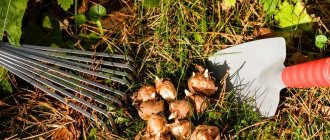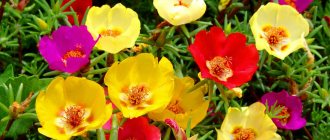A plant such as gillyflower (Matthiola) is also called matthiola. It is related to the genus of herbaceous annual and perennial plants of the cruciferous or cabbage family. Under natural conditions, the greyhound can be found in Southern Europe, Africa and neighboring areas of Asia. There are 20–50 species in this genus. This plant is an ornamental plant with fragrant flowers. R. Brown gave the Latin name to this flower in honor of the Italian P. Mattioli, a doctor and botanist who lived in the 16th century. The name Levkoy comes from Italian, German or Latin. The fact is that these languages have similar source words. From Greek, “levkoy” is translated as “white violet.” In the 20th century, such a plant could be found in almost any park and garden, but in the 21st century, for some reason such a flower went out of fashion. If you are a fan of the park style, then this flower is what you need.
Features of gillyflower
Levkoy is a herbaceous plant or subshrub that can be perennial, biennial or annual. The height of erect branched shoots can vary from 0.2 to 0.8 meters; they are covered with felt pile or bare. Leaf blades of lanceolate or oblong shape can have a jagged or solid edge. The racemose or spike-shaped inflorescence consists of double or simple flowers, which can be colored pink, purple, white and dirty yellow. Flowering is observed in June-November. The fruit is a pod containing flat, narrow-winged seeds. The aroma emanating from gillyflower flowers cannot be confused with any other. Varieties with simple flowers are considered excellent honey plants, while double ones are a wonderful decoration for any garden. Anyone can grow such a flower, even those people who are far from gardening.
Types and varieties
According to the timing of the growing season, Levkoy is divided into:
- Annual (summer)
- Winter (perennial)
- Autumn (hybrid)
Annual - characterized by the shortest growth phase. They are sown in early spring, bloom in summer, and seeds ripen by autumn.
The most valuable varieties are those that produce seeds of double flowers.
Summer gillyflower is the most popular among gardeners. They are sown in open ground.
Annual species include a huge number of varieties, different in shape, size, shades, and flowering duration.
On a note!
Seeds with double flowers can be correctly identified by the condition of the pods. Double seeds are formed in small, short fruits with blunt tips. Such bushes look more stunted, nailed to the ground.
Winter - sown at the end of summer, and it blooms next spring. This species is a biennial herbaceous plant. Winter gillyflower is grown as a potted species indoors. Since due to late flowering, before the onset of cold weather, the flowers do not have time to fully reveal their potential.
Autumn - this species has the longest cycle of development and growth.
Sown in early spring, first flowering appears in mid-summer, early autumn. The plant remains flowering until frost. Fruit pods with seeds ripen next year.
This species is popular among gardeners; it is used in combination with other flowers to create decorative solutions.
Mathiolla is distinguished by the shape of the inflorescences and appearance into 8 groups:
Bouquet
Widely used in floristry, in the design of gardens and flower beds.
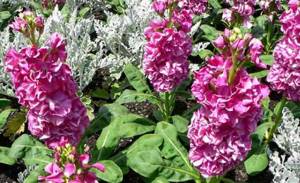
Low bushes 30-35 cm, have an oval elongated leaf shape, purple-green color.
The inflorescences consist of double flowers, which are located tightly to each other. These racemes can grow from 2.5 to 3.5 cm in diameter. The main and lateral inflorescences grow at the same level.
The flowering period for bouquet matiollas is 60-75 days.
Gigantic
This species grows dense, wide, tapering foliage. Bushes 50-60 cm high.
The main inflorescence blooms first and is larger than the others, reaching 15-20 cm in diameter. The inflorescence is densely double, but not dense.
Many varieties bloom in late summer - early autumn and are used by florists to make bouquets.
Quedlinburg
Includes all varieties of double flower forms. Based on appearance and flowering time, they are divided into the following groups:
- Tall, bushy, late flowering bushes – these bushes are highly branched and grow widely. Height from 50-60 cm. The leaves are elongated oval in shape, either smooth or jagged. They bloom from mid-summer, 1-1.5 months.
- Tall, bush-like, early-flowering varieties - the characteristics of the bushes are similar to late-flowering varieties. They differ in that they bloom early, in early June and for two months; large flowers bloom in inflorescences, up to 5 cm in diameter.
- Low-growing early bushes - branched bushes have a round shape, grow up to 40 cm. The leaves are elongated, oval, purple-green. It has racemose inflorescences with large flowers. It blooms starting in June for two months.
- Six-shaped - a flower with an erect, slightly curved stem, growing up to 60-80 cm. The leaves are elongated, lacent. The inflorescences are large, loose, consisting of large flowers. The lateral inflorescences are located below the main one. Flowering is not long, about 25-30 days. This group is ideal for arranging bouquets.
Erfurdish
The branches grow up to 40 cm in height and are densely overgrown with leaf blades. The leaves are oblong, oval. It blooms with many semicircular flowers from July to the end of August. The central inflorescence is higher than the lateral ones. This species is often used by florists.
Single-stem
It has a straight, tall stem, up to 80 cm in height. Large, densely double flowers grow on a single stem. The leaves are large, diamond-shaped. Flowering period is 1 month.
Pyramid
This group includes plants that resemble a pyramid. And they are divided by size:
- Dwarf - miniature branched bushes, growing up to 25 cm. The leaves are large, wide, elongated. From July to the end of August it blooms with bright, fragrant flowers.
- Semi-tall - bushes up to 45 cm tall, with narrow, long leaves. The side and central shoots are on the same level. Earlier, long flowering, from the beginning of June.
- Gigantic large-flowered plants - this includes branched plants from 50-80 cm in height. It blooms with densely double flowers from mid-summer to September.
Spreading
- Large-flowered - bloom from July to the end of November. The flowering is fragrant, up to 5-6 cm in diameter. The bushy stem grows up to 60-70 cm. The leaves are oblong and large.
- Remontant - flowering begins in July and lasts until the first frost. Large flowers bloom sequentially, in groups. Branched bushes reach 50-70 cm in height. The leaves are oval, smooth, and have a serrated edge.
Popular varieties
Step is a tall annual. It blooms in mid-summer and blooms until September with large dark red flowers. Has a rich aroma. Found in garden plots, parks and city flower beds.
Bouquet - low-growing bushes up to 35 cm. Has double red blooms.
Rosetta is a double leftflower, reaches an average height of 50-60 cm. Flowering is pink.
Gray is a herbaceous annual. The height of the plant varies from 25 to 80 cm. The flowers are pale lilac. The stems can be simple or branched, and by the end of the season they are usually woody.
Rhineweiss - bushes about 70 cm. There are white, densely double flowers.
Diana is a tall growing bush with a dark line on large pink flowers.
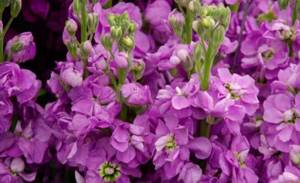
Royal mixture - low dense bushes grow up to 40 cm. Both simple and double shades have a wide variety of shades. Blooms from mid-summer to September. Often used by florists to make bouquets. These flowers retain their freshness and beauty for a long time even after cutting.
Caprice is a low-growing variety. Lacentate-shaped leaves are densely located at the base of the plant. The spike-shaped inflorescences bear double or semi-double flowers. Blooms throughout the summer. Flowerbeds are planted in the foreground for landscaping. Also popular for indoor growing.
Growing gillyflower from seeds

Sowing
Before you start sowing, you need to prepare the seeds. To do this, they are soaked in water for 24 hours, and then placed in moistened gauze and put on the refrigerator shelf for several days for stratification. Sowing seeds for seedlings is carried out in the last days of March or the first days of April in boxes or containers, which must first be filled with a moistened soil mixture, which includes turf soil and sand (3:1). Sowing should be done sparsely, and the seeds should be buried only half a centimeter. Then the container must be covered with film or glass and moved to a warm (20 to 22 degrees) and dark place. In some cases, the first seedlings can be seen in just 4–5 days, but they can appear in half a month.
Seedling
After the first seedlings appear, the shelter must be removed and the container moved to a well-lit place with diffused light, this will not allow the plants to stretch out. The required temperature for growing seedlings is from 10 to 12 degrees, so it is recommended to move the containers to an unheated veranda or a protected balcony. Two days after the first seedlings appear, they will need to be watered for the first time. After 10–12 days, seedlings should be planted in individual pots with holes for drainage. They should be filled with an earth mixture consisting of turf and leaf soil and sand, which must be taken in a ratio of 2:2:1. It should be taken into account that by this time the plants will not yet have a single true leaf blade. When planting seedlings, it is recommended to pour a small amount of hydrogel into the substrate, which will strengthen the plant’s root system. Late, as well as mid-flowering varieties, if desired, can be planted directly into open soil. The first fertilizing should be done when the plants begin to develop their second true leaf blade. For fertilizing, microfertilizers should be used; for this, 0.3 grams of boric acid and copper sulfate and 0.1 grams of manganese sulfate and zinc sulfate are taken per 1 liter of water. Seedlings of such a plant must be hardened off. To do this, first open the window on the balcony for a short time, while the procedure time is gradually increased. Finally, the flowers should be kept with the window completely open. You should start hardening off seedlings 1–1.5 weeks before planting in open soil.
Levkoi!!! Sowing seeds for seedlings, further care
Planting gillyflower in open ground
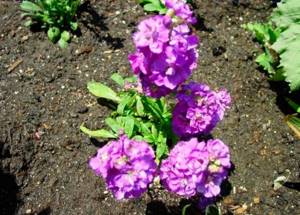
What time to plant
Planting of gillyflower seedlings should be done in the last days of May. To do this, you need to choose a cloudy day or plant in the evening, because the scorching rays of the sun can ruin newly planted seedlings. An area where plants belonging to the cruciferous family previously grew is not suitable for planting matthiola, otherwise the flowers may be destroyed by the cruciferous flea beetle. It should also be taken into account that the soil from such a site is also not suitable for filling containers for growing lefty seedlings, because there is a high probability that the plants will get sick with blackleg or clubroot.
When choosing a place for planting, you should take into account that such plants need a lot of sunlight and well-drained soil, since if liquid stagnates in the soil, this can greatly harm the leaves. The soil should be neutral or slightly alkaline, saturated with nutrients, and it is better if it is sod-loamy or sod-sandy loam. Fertilizers should be applied to the soil before planting only when it is excessively depleted.
How to plant
First you need to prepare the holes, and then fill them with water. Planting should be done directly into the earthen slurry, this will allow the plants to quickly adapt to new conditions. When the holes are filled with soil, it needs to be thoroughly compacted. The distance between low-growing and single-stem varieties should be about 15–20 centimeters, and between branched and tall varieties - from 25 to 30 centimeters.
Caring for gillyflower in the garden

The most important thing to remember when growing matthiola is that it reacts extremely negatively to both prolonged drought and too much watering. In this regard, watering should be moderate and necessarily systematic. Also, when caring for such a plant, it is necessary to weed it in time and systematically loosen the surface of the soil in the area, and this should be done every time after the plant is watered. When it comes to organic matter, only wood ash should be used for fertilizing, but it is preferable to use complex mineral fertilizer. So, in spring, complete mineral fertilizer should be added to the soil in the area where matthiola grows, and during flowering, phosphorus-potassium fertilizer is used for feeding. If you are planting perennial matthiola, remember that it should not be mulched the year it is planted.
Reproduction of gillyflower
You can grow matthiola from seeds, but if you want such plants to bloom on your site throughout the season, you need to sow them every 1.5–2 weeks. Terry matthiola is sterile, however, it was noticed that double flowers grow from those seeds that were collected from underdeveloped bushes with simple flowers, and they should have short pods pressed to the shoot with a blunt end. From seeds collected from such bushes, plants with both simple and double flowers can grow in a 1:1 ratio. When growing seedlings, you can try to select plants with double flowers, if necessary. To do this, the seedlings should be kept at an air temperature of 12 to 15 degrees. After this, they are moved for several days to a room where the air temperature is 6–8 degrees, at this stage you will be able to see the differences. For plants with double flowers, the cotyledon leaves will be larger and not as bright. If necessary, it will be possible to select bushes with double flowers, while removing the remaining shoots.
Diseases and pests

The cruciferous flea beetle can cause the greatest harm to such a plant. To get rid of a small number of insects, you should use an ash solution. The treatment of affected bushes with this product should be carried out once every 4-5 days, and it should be repeated 3 times. During processing, it is very important that the solution gets on both the front and back sides of the leaves. If there are a lot of fleas, to destroy them you will need to use insecticidal agents, for example: Decis, Aktara, Actellik, Bankol and Intavir.
Mattiola most often gets sick with blackleg. In an infected bush, the lower part of the shoot first turns brown, and after a while turns black. It is impossible to cure such specimens, but infection can be prevented; to do this, before planting seedlings, the soil should be treated with Hom. In this case, even if the soil was infected by a carrier of blackleg, the plants will still not get sick with this disease.
Terry coefficient
Levkoi have one interesting feature. In the description of the variety on the bag of seeds you can sometimes find such an indicator as terry coefficient . The thing is that seeds of one variety produce plants with simple and double flowers.
A simple flower fades in about 5 days and after that it sets seeds, from which both simple and double gillyflowers also grow. Double flowers are much more decorative and bloom for up to 3 weeks, but are sterile and do not produce seeds.
Read also: Secrets of growing monarda in the garden
The ratio of double and simple plants shows this coefficient. For example, if this indicator is 50, then there will be approximately equal numbers of double and single flowers, and if it is 90, almost all will be double. Already among the young seedlings, signs are visible by which double plants can be distinguished. They have larger leaves that are lighter in color.
Such plants are selected for cultivation in ornamental plantings or for cutting, depending on the variety. The rest of the seedlings are planted separately, creating unfavorable conditions. It is on the weakest and most deformed shoots that the most beautiful terry specimens grow.
In varieties with a high terry coefficient, few seeds are set due to the small number of simple flowers, so their price is usually much higher. But this more than justifies their magnificent appearance.
Levka after flowering
Collecting seeds

The seeds become ripe in September or October. Wait until the pods change their color to brown, and then completely pull out the bush along with the roots and put it in a well-ventilated room. Wait for it to dry completely. Dry pods need to be torn off and the seeds poured out of them.
Preparing for winter
If gillyflower is grown in a region with cold winters, then they are cultivated as annual plants. In this regard, in autumn, plants should be pulled out of the soil before they completely wither. Plant residues will need to be disposed of, and the area where the gillyflower grew will need to be dug up. If winters in the region are relatively mild, then after frosts begin, the bushes will need to be pruned to the level of the ground surface. If you wish, you can decorate your home with gillyflower in the winter; to do this, the bush must be dug up and transplanted into a flower pot.
Mattiola - planting and care
Matthiola is a modest herbaceous representative of the cruciferous family.
It is native to Southern Europe and also grows in the Mediterranean and surrounding regions.
Surprisingly, the ancient Greeks used this plant to decorate the halls during feasts.
Today flower growers know both annual and perennial matthiola; planting and caring for it in the open ground is not the easiest task, especially for beginners.
Nevertheless, the result will please you, because the inconspicuous plant has one remarkable advantage - a delicate fragrant aroma, reminiscent of the smell of violets.
Ornamental matthiola has a straight stem and rich green leaves. It will decorate the garden with small flowers of soft blue, snow-white, light yellow and purple tones. The racemose inflorescences are clearly inferior in beauty to the more striking inhabitants of the site.
However, in the evening you can go out onto the balcony or look out the open window to inhale the unique fragrant aroma. At sunset, the “night violet” smells especially strongly and gives the feeling of being on the Mediterranean coast. This is why flower growers love her.
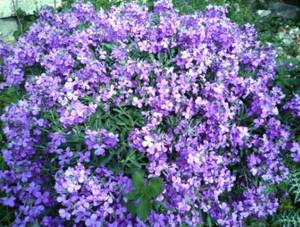
The most common are two-horned matthiola and gray-haired (the second name is levkoy). Winter forms of biennial gillyflower are grown in greenhouses for cutting or as a potted crop. Summer and autumn forms are suitable for planting in open ground.
Read also: How to properly grow balsams in the garden


